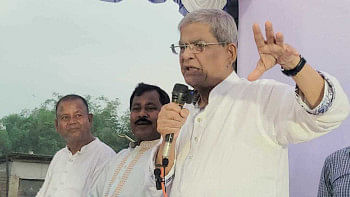Link between nutrition and agriculture
WE recognise that increasing agricultural productivity and promoting good nutrition are deeply interrelated aspects of addressing hunger and poverty. In Bangladesh, nutritional deficiencies -- in energy, vitamins, and minerals -- are widespread, particularly among pregnant women and young children. Poor nutrition during the 1,000-day period from conception through the first two years of life adversely affects the development of the child's future health and productivity.
Women are at the nexus of agriculture, nutrition, and health. As smallholder farmers and caretakers of children, women make daily food production and consumption decisions for their families. Given the significant time constraints on women, interventions that affect women's time allocation can help improve their own nutrition as well as that of their children.
Increased agricultural productivity can improve nutrition in several ways. Programmes that directly interact with farmers can deliver significant information about practices and behaviours that improve nutrition, alongside information on agriculture.
The potential gender disparities of programmes linking smallholders to markets need to be directly addressed to realise the full benefits of such programmes for improved health and nutrition. We need to integrate health and safety concerns with the introduction of new technologies and markets, ensure that both women and men are trained to minimise exposure to agrochemicals, and enforce compliance with bio-safety requirements.
The strategy aims to increase dietary diversity using household labour intensively on small gardens within the homestead, allowing women to grow a variety of fruits and vegetables and tend small livestock while fulfilling their domestic and childcare responsibilities.
In rural areas, there are very few employment opportunities. Even though they have little or no land these women are knowledgeable, experienced and adaptable environmental managers, because sustainable natural systems are fundamental to the survival of their families and their livelihoods. These women may be taught to increase their own knowledge of the environment and concern for its sustained well-being.
There is now strong evidence that the earth's environment is changing rapidly, mainly due to human activities. Increasing temperatures, sea level rises, changing patterns of precipitation, and more frequent and severe extreme events are expected to have largely adverse effects on key determinants of human health.
Women, young people, and people with low socioeconomic status are thought to be at comparatively higher risk of anxiety and mood disorders. Saline contamination is expected to be aggravated by climate change and sea-level rises. A paper on saline contamination of drinking water in Bangladesh indicated that large numbers of pregnant women in coastal areas are being diagnosed with pre-eclampsia, eclampsia and hypertension because of it.
Climate change can affect migration in three distinct ways. First, the effects of warming and drying in some regions will reduce agricultural potential and undermine ecosystem services. Second, there will be increase in extreme weather events, particularly heavy precipitation resulting in flash or river floods in tropical regions. Finally, sea-level rises are expected to destroy extensive and highly productive low-lying coastal areas that are home to millions of people, who will have to relocate permanently.
Climate variables also have an impact on human health in both rural and urban areas. They indirectly change the economic and socio-political factors that govern food access and utilisation, and can threaten the stability of food systems.
We believe that we can more effectively reduce the critical problems of hunger and malnutrition among women and children in the developing world if the agriculture and nutrition sectors work together. This has led our agricultural development and nutrition teams to seek complementary and collaborative approaches in these areas.
The success of nutrition security policies hinges on their ownership by the various ministries and relevant stakeholders. It requires mapping of the public and private institutions engaged in agriculture and nutrition policy development and programmes, and the identification of existing strategic and implementation plans. Member states of WHO have endorsed global targets for improving maternal, IYCF by 2025 and are committed to monitoring progress. Since many ministries are often involved in promoting nutrition security, identifying leadership will help to ensure that policies are drawn and programmes implemented properly.
To promote optimum contribution of the agriculture sector to food and nutrition security, agriculture policies should include explicit nutrition objectives and indicators. For instance, the 2012-2016 agricultural sector strategy includes a goal on the reduction of child malnutrition, forcing it to align strategies to reduce food insecurity with strategies to reduce nutrition insecurity. So if health and non-health (trade, finance, climate change, education,) sectors work together then we will able to ensure a healthy and productive nation.
The writer is nutritionist, Bio-lab health & wellness center.

 For all latest news, follow The Daily Star's Google News channel.
For all latest news, follow The Daily Star's Google News channel. 



Comments